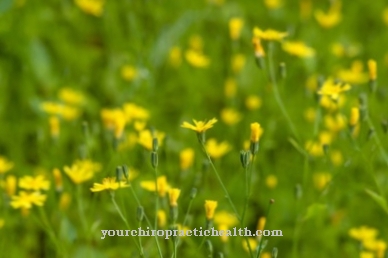The Common chickweed belongs to the carnation family. The annual plant is considered a weed in Germany because it spreads particularly quickly like a carpet on cultivated areas within a short time. As a medicinal plant, the chickweed has many beneficial effects on various ailments and diseases.
Occurrence and cultivation of the common chickweed

The fast-growing plant is insensitive and tough, it can withstand freezing temperatures and even blooms in snow. Although the chickweed is considered a weed, it is actually a boon to the soil as it protects bare, cracked or dry soils from erosion. It is a weak base and weak acid indicator, a special nitrogen indicator and brings an orderly character to nutrient-rich garden, arable and weed corridors.
The stems of the summer annual creeping therophyte are up to 40 centimeters long and mostly stay on the ground, where they form small, additional roots. The small leaves are ovate and tapered to a point. A flower has about ten leaves, which gives it a star-shaped look. The five white petals grow in two parts. In dry weather, they unfold in the morning. Anyone who regularly observes the small star blossoms can see that they always open at the same time around nine o'clock.
In wet weather, the flowers remain closed. Since the chickweed also blooms in winter, it is also referred to as a winter annual biennial, although its occurrence is less common. The flowers form capsules that produce a large number of seeds. The six-lobed capsule fruits hang down curved on the plant stem and are able to produce up to 15,000 seeds annually.
Effect & application
The common chickweed is not only suitable as a medicinal plant, but also as a supplier of food and luxury goods, from which additives for wild vegetables, herbal quark, wild lettuce, spices, teas and soups are prepared. Their taste is reminiscent of young vegetable corn. As a medicinal plant, its effect is hemostatic, blood-purifying, astringent, expectorant, cooling, relieving itching, promoting menstruation, promoting milk production and diuretic.
It is used for coughs, springtime tiredness, flatulence, hemorrhoids, joint inflammation, skin diseases, and constipation. The medicinal plant is also used for diseases of the respiratory tract such as bronchitis, rheumatism, bruises, boils, eczema, pimples, ulcers and kidney inflammation. Prepared as tea from the dried flower petals, chickweed stimulates the metabolism, relieves infections of the respiratory tract and rheumatic complaints.
As a poultice, the carnation has a positive effect on wounds that are difficult to heal, itching and eczema. Pharmacies offer ointments specially enriched with the active ingredients of chickweed. The collection time is all year round, as the bird star herb blooms in cold temperatures even in winter. However, the preferred harvest time is in spring and summer. Essential oils, minerals, flavonoids, oxalic acid, mucus, zinc, saponins, coumarins and vitamins act as ingredients.
Importance for health, treatment & prevention
The common chickweed is of great importance for naturopathy and alternative medicine, as it has a pain-relieving effect and can be used against various internal and external diseases. In homeopathy, the plant components are processed in the form of flower essences, tablets or globules as complex and individual remedies. These homeopathic active ingredients stand for self-confidence, tenacity and perseverance.
The medicinal plant is available in drop form as PHÖNIX Stellaria drops. It is a special homeopathic remedy from the spagyric therapy direction. It goes back to the homeopathic-spagyric drug pictures, which include degenerative and inflammatory processes. In addition to the chickweed, a large number of other plant components are active in these drops. Spagyric pursues holistic, medical treatment approaches. The naturopathic treatment considers mind (Mercurius), body (Sal) and soul (Sulfur) as one unit.

The spagyric approach goes back to the doctor and alchemist Paracelsus (1493–1541). He also used the much better known synonym alchemy. Homeopathic remedies receive the strongest substances of chickweed in refined form through their potentiation. Its therapeutic effect is stronger than the natural, herbal raw material due to the dilution and subsequent potentization. These alternative medicines can be absorbed by the human organism without risk, as they have been freed from all toxins and pollutants without losing their effectiveness. 50 grams of chickweed can meet an adult's daily vitamin requirement.
The carnation plant resembles both the prickly chickweed (S. nemorum ssp. Glochidisperma) and the water intestine (Myosoton aquaticum). Both plants have a slightly poisonous effect that can cause various complaints such as headaches, nausea and vomiting. Therefore, when collecting the star chickweed, attention should be paid to its easily and clearly visible identification mark, the one-sided hair on the stem, in order to avoid confusion with its poisonous "colleagues". Stella media is compatible with all components. For this reason, the whole plant and not just individual components are used.
In unprocessed form, excessive amounts should not be consumed due to the saponins and essential oils, as the plant components can cause minor complaints such as nausea or headaches. However, when used in small amounts, the common chickweed does not develop any adverse effects. The plant parts should also not be used if there is a known hypersensitivity to one or more of the ingredients.




























